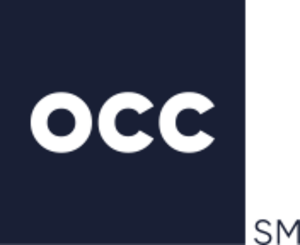Options Clearing Corporation facts for kids
 |
|
| Industry | Financial services |
|---|---|
| Founded | 1973 |
| Headquarters | Chicago, Illinois, U.S. |
| Products | Clearing house (finance), Equity derivatives clearing |
The Options Clearing Corporation (OCC) is a special financial company in Chicago, USA. It acts like a trusted middleman for financial agreements called options and futures. The OCC makes sure that these deals are completed safely and correctly.
It works with 16 different exchanges, which are places where people buy and sell financial products. The OCC helps clear and settle these trades. This means they stand between the buyer and seller, guaranteeing that both sides keep their promises. They handle many types of financial agreements, including options, futures, and securities lending.
The OCC holds about $100 billion in money and assets from its members. This money acts as a guarantee. Every day, billions of dollars move through the OCC. In 2011, it became the largest company in the U.S. for clearing equity options. In 2016, it cleared 4.17 billion contracts, which was one of its busiest years ever.
The OCC is watched over by two important government groups: the Securities and Exchange Commission (SEC) and the Commodity Futures Trading Commission (CFTC). These groups make sure the OCC follows the rules. The OCC is also known as a "Systemically Important Financial Market Utility" (SIFMU). This means it's a very important part of the financial system. The OCC is run by a group of leaders called a board of directors. Most of its money comes from fees it charges its members for clearing services.
How the OCC Started and Grew
The Options Clearing Corporation (OCC) began in 1973. At first, it was a clearing house for five markets that traded equity options. Before the OCC was created, the Chicago Board Options Exchange had its own clearing company.
Over the years, the number of options deals handled by the OCC grew a lot. This showed that more and more people were using equity options. For example, in October 2000, the OCC cleared 75.3 million contracts in one month. By August 2011, this number jumped to a record 550 million contracts in a single month.
In 2011, a company called Standard & Poor's changed the OCC's financial rating. The OCC said this change would not affect its operations or its ability to meet its promises.
Also in 2011, the OCC made a deal to clear a new type of option called "over-the-counter" (OTC) options. These options were based on important stock market indexes like the S&P 500. This was the first time a clearing house cleared these kinds of OTC options. In July 2012, the OCC was officially named a Systemically Important Financial Market Utility (SIFMU). This was part of a big financial law called the Dodd-Frank Act.
In September 2013, the OCC worked to follow new rules in Europe. This made it easier for banks in Europe to trade U.S. options. This helped them avoid higher costs. In the same month, Craig Donohue became the executive chairman of the OCC. He was seen as someone who would bring change to the company. In January 2014, the OCC got approval to officially clear OTC equity index options. These services started in April 2014.
In September 2014, the OCC and U.S. options exchanges announced new safety rules. These rules were designed to prevent mistakes or unwanted trading activity. They aimed to reduce financial losses for traders and the OCC. In June 2016, the OCC added a small fee for trades made on exchanges that did not follow these new safety rules. The OCC also gave back money to its clearing members and stockholder exchanges.
In February 2023, the Commodity Futures Trading Commission (CFTC) issued an order against the OCC. The CFTC found that the OCC did not have good enough rules to manage risks with its computer systems. The OCC agreed to pay a $5 million penalty for these issues.
Who Works with the OCC?
The OCC works with many different exchanges where options are traded. These include: BOX Options Exchange, Cboe BZX Exchange, Cboe C2 Exchange, Cboe EDGX Exchange, Cboe Exchange, Miami International Securities Exchange, MIAX PEARL, Nasdaq GEMX, Nasdaq ISE, Nasdaq BX, Nasdaq MRX, Nasdaq PHLX, Nasdaq Options Market, NYSE American Options, and NYSE Arca.
The OCC's clearing members are about 115 of the largest financial companies in the U.S. and other countries. These members serve both professional traders and regular customers.
The OCC also helps clear trades in other markets. This includes commodity futures, commodity options, and security futures. They clear futures contracts traded on exchanges like CBOE Futures Exchange and NYSE Liffe. The OCC also helps with securities lending. This is where people borrow and lend stocks.
The OCC also supports the Options Industry Council (OIC). The OIC is a group that teaches people about exchange-listed options. The OCC helps fund and manage the OIC.
What is Margining?
An important part of how a clearing company works is called "margin requirement." This is a certain amount of money that members must put aside. It helps the OCC manage "credit risk," which is the chance that a member might not be able to pay what they owe.
For many years, the OCC used a system called TIMS (Theoretical Intermarket Margin System). But in 2006, they switched to a newer and more advanced system. This new system is called STANS (System for Theoretical Analysis and Numerical Simulations).
See also
- Securities market participants (United States)
- CCP Global

